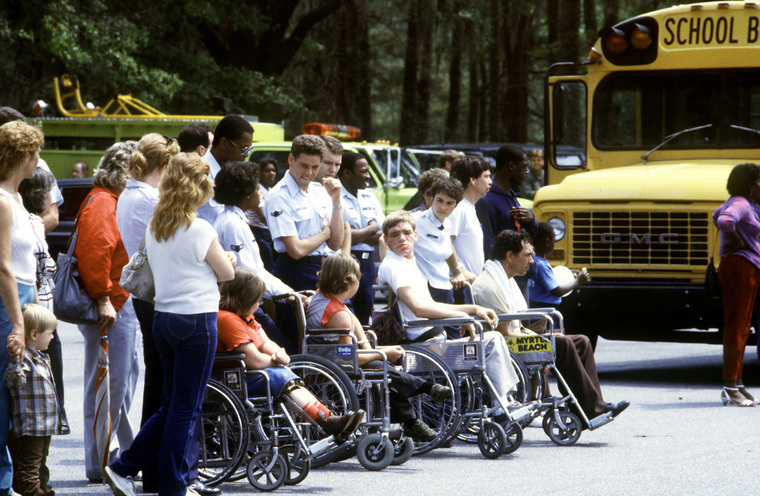Pedestrian in Wheelchair Struck, Killed by Bus
Earlier this month, while many were enjoying their weekend evenings, a woman in a motorized wheelchair was killed when she was struck by a Regional Transportation Commission bus in North Las Vegas. The incident occurred around 6pm at the intersection of Las Vegas Boulevard North and Civic Center Drive. It appears that the woman was crossing the street in the crosswalk when she was struck by the bus and was subsequently trapped under the front left tire of the bus. The woman, who was only 28 years old, died at the scene. Police do not believe that excessive speed or impairment from drugs or alcohol were factors in this accident. [1]
While there are few large trucks and buses on the road (compared to smaller passenger cars), these massive vehicles are deadly when they are involved in accidents. In 2016, 4,400 large trucks and buses were involved in fatal crashes in the United States. Of the fatal crashes involving buses between 2006 and 2016, 13 percent involved inter-city buses like Greyhounds, 40 percent involved school buses, and 34 percent involved regular intra-city transit buses. Over the last year, the number of large trucks involved in fatal crashes has increased by 3 percent, while the number of buses involved in similar incidents has decreased by 14 percent. [2]
This accident described above was unusual because it involved an individual with a disability. For decades, it was difficult to assess the risk to individuals using wheelchairs on sidewalks and streets. Police reports often fail to mention whether a victim was using a wheelchair at the time of an accident, making the data hard to parse at this granular level of detail. According to a recent study by Georgetown University, pedestrians in wheelchairs are 30 percent more likely to be killed in a road accident than a walking pedestrian. Of these individuals, men in wheelchairs were five times more likely than women to be killed in a roadside accident. In fact, in 75 percent of crashes involving a wheelchair, the driver made no maneuvers, either braking or steering, to avoid the collision. [3]
The fact that many of the drivers in these incidents failed to even brake to avoid the pedestrian suggests that they did not see the wheelchair user crossing the street. People in wheelchairs are closer to the ground, and they may not be in the field of vision the driver is scanning when he or she approaches an intersection. Electric wheelchairs also move faster than many walking pedestrians, putting them more suddenly in the path of the oncoming vehicle. [4] It may also be the case that a walking pedestrian can evade a vehicle more easily than a wheelchair user (if the pedestrian anticipates the crash).
Many of these deaths may be attributed in part to the fact that many cities are not designed with wheelchair users in mind. For those with physical disabilities, barriers to personal transportation are numerous in urban environments. Even when there is infrastructure available, wheelchair ramps are often overlooked or blocked, and elevators to subways or skywalks are frequently out of service. Even something as simple as a bathroom visit becomes virtually impossible for a person living with a physical disability, unless the facility was designed with wheelchair users in mind. [5] Under the Americans With Disability Act (ADA), city sidewalks are supposed to be designed with wheelchair-accessible curbs. While these small, ADA-compliant ramps make crosswalks more accessible to wheelchair users, they do little to keep those individuals safe once they are in the intersection. [6]
One country that has been a leader in accessible city planning is Singapore. For the past thirty years, Singapore authorities have been working to improve accessibility for people with disabilities by installing more lifts, wider gates, and tactile guidance. Over 80 percent of Singapore’s subway stations have barrier-free routes that individuals in wheelchairs can easily navigate. There is a wide range in the accessibility of transportation systems for people with disabilities in the United States, ranging from Seattle – where many neighborhoods don’t even have sidewalks – to Washington D.C., where every subway station is fully wheelchair accessible [7]
Because city infrastructure will inevitably lag behind the best safety practices, drivers should always be extra cautious and considerate of wheelchair users. Understand that wheelchair users are pedestrians, and they are entitled to use public spaces like sidewalks and crosswalks. Always stop within five feet of a crosswalk to give wheelchair users plenty of space. Watch out for pedestrians in wheelchairs on curb ramps, and always look before you turn right on red. [8]
Because there will always be distracted drivers on the road, pedestrians in wheelchairs should take a few simple steps to keep themselves as safe as possible when trying to navigate roads and sidewalks. Plan your route out ahead of time to make sure there are appropriate sidewalk ramps and well-marked crosswalks. Always obey walk/don’t walk signs, even if you think it is safe to cross the street. Stay extra alert at railroad crossings, as these intersections can be especially dangerous for individuals in wheelchairs. If you notice a construction zone that has interrupted the normal flow of things and is not compliant with the ADA, report it to local law enforcement. Use caution even when you have the right of way, and never assume that drivers and cyclists see you – remember that wheelchairs are closer to the ground, and frequently go unnoticed by distracted drivers. [9]
If you are injured by a vehicle while using a wheelchair, make sure you contact a personal injury attorney to understand your rights.
[2] https://www.fmcsa.dot.gov/safety/data-and-statistics/large-truck-and-bus-crash-facts-2016
[5] https://www.theguardian.com/cities/2018/feb/14/what-disability-accessible-city-look-like
[7] https://www.theguardian.com/cities/2018/feb/14/what-disability-accessible-city-look-like
[8] https://www.onlineloancalculator.org/resources/disabled-pedestrians.php
[9] https://www.onlineloancalculator.org/resources/disabled-pedestrians.php


